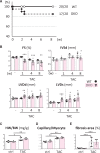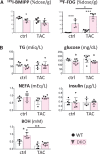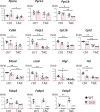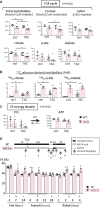Glucose is preferentially utilized for biomass synthesis in pressure-overloaded hearts: evidence from fatty acid-binding protein-4 and -5 knockout mice
- PMID: 29554241
- PMCID: PMC6014234
- DOI: 10.1093/cvr/cvy063
Glucose is preferentially utilized for biomass synthesis in pressure-overloaded hearts: evidence from fatty acid-binding protein-4 and -5 knockout mice
Abstract
Aims: The metabolism of the failing heart is characterized by an increase in glucose uptake with reduced fatty acid (FA) oxidation. We previously found that the genetic deletion of FA-binding protein-4 and -5 [double knockout (DKO)] induces an increased myocardial reliance on glucose with decreased FA uptake in mice. However, whether this fuel switch confers functional benefit during the hypertrophic response remains open to debate. To address this question, we investigated the contractile function and metabolic profile of DKO hearts subjected to pressure overload.
Methods and results: Transverse aortic constriction (TAC) significantly reduced cardiac contraction in DKO mice (DKO-TAC), although an increase in cardiac mass and interstitial fibrosis was comparable with wild-type TAC (WT-TAC). DKO-TAC hearts exhibited enhanced glucose uptake by 8-fold compared with WT-TAC. Metabolic profiling and isotopomer analysis revealed that the pool size in the TCA cycle and the level of phosphocreatine were significantly reduced in DKO-TAC hearts, despite a marked increase in glycolytic flux. The ingestion of a diet enriched in medium-chain FAs restored cardiac contractile dysfunction in DKO-TAC hearts. The de novo synthesis of amino acids as well as FA from glycolytic flux was unlikely to be suppressed, despite a reduction in each precursor. The pentose phosphate pathway was also facilitated, which led to the increased production of a coenzyme for lipogenesis and a precursor for nucleotide synthesis. These findings suggest that reduced FA utilization is not sufficiently compensated by a robust increase in glucose uptake when the energy demand is elevated. Glucose utilization for sustained biomass synthesis further enhances diminishment of the pool size in the TCA cycle.
Conclusions: Our data suggest that glucose is preferentially utilized for biomass synthesis rather than ATP production during pressure-overload-induced cardiac hypertrophy and that the efficient supplementation of energy substrates may restore cardiac dysfunction caused by energy insufficiency.
Figures







Comment in
-
Fatty acids are the best fuel for overloaded hearts.Cardiovasc Res. 2018 Jul 1;114(8):1055-1056. doi: 10.1093/cvr/cvy106. Cardiovasc Res. 2018. PMID: 29718157 No abstract available.
Similar articles
-
Myocardial fatty acid uptake through CD36 is indispensable for sufficient bioenergetic metabolism to prevent progression of pressure overload-induced heart failure.Sci Rep. 2018 Aug 13;8(1):12035. doi: 10.1038/s41598-018-30616-1. Sci Rep. 2018. PMID: 30104639 Free PMC article.
-
Robust suppression of cardiac energy catabolism with marked accumulation of energy substrates during lipopolysaccharide-induced cardiac dysfunction in mice.Metabolism. 2017 Dec;77:47-57. doi: 10.1016/j.metabol.2017.09.003. Epub 2017 Sep 20. Metabolism. 2017. PMID: 28941596
-
CD36 knockdown attenuates pressure overload-induced cardiac injury by preventing lipotoxicity and improving myocardial energy metabolism.Int J Med Sci. 2025 Feb 18;22(5):1223-1236. doi: 10.7150/ijms.107224. eCollection 2025. Int J Med Sci. 2025. PMID: 40027179 Free PMC article.
-
Metabolic remodelling of the failing heart: beneficial or detrimental?Cardiovasc Res. 2009 Feb 15;81(3):420-8. doi: 10.1093/cvr/cvn282. Epub 2008 Oct 14. Cardiovasc Res. 2009. PMID: 18854380 Review.
-
Targeting fatty acid and carbohydrate oxidation--a novel therapeutic intervention in the ischemic and failing heart.Biochim Biophys Acta. 2011 Jul;1813(7):1333-50. doi: 10.1016/j.bbamcr.2011.01.015. Epub 2011 Jan 20. Biochim Biophys Acta. 2011. PMID: 21256164 Review.
Cited by
-
High Throughput Procedure for Comparative Analysis of In Vivo Cardiac Glucose or Amino Acids Use in Cardiovascular Pathologies and Pharmacological Treatments.Metabolites. 2021 Jul 30;11(8):497. doi: 10.3390/metabo11080497. Metabolites. 2021. PMID: 34436438 Free PMC article.
-
The pyruvate-lactate axis modulates cardiac hypertrophy and heart failure.Cell Metab. 2021 Mar 2;33(3):629-648.e10. doi: 10.1016/j.cmet.2020.12.003. Epub 2020 Dec 16. Cell Metab. 2021. PMID: 33333007 Free PMC article.
-
TIGAR Deficiency Blunts Angiotensin-II-Induced Cardiac Hypertrophy in Mice.Int J Mol Sci. 2024 Feb 19;25(4):2433. doi: 10.3390/ijms25042433. Int J Mol Sci. 2024. PMID: 38397106 Free PMC article.
-
Semaglutide ameliorates cardiac remodeling in male mice by optimizing energy substrate utilization through the Creb5/NR4a1 axis.Nat Commun. 2024 Jun 4;15(1):4757. doi: 10.1038/s41467-024-48970-2. Nat Commun. 2024. PMID: 38834564 Free PMC article.
-
Metabolic Remodeling Promotes Cardiac Hypertrophy by Directing Glucose to Aspartate Biosynthesis.Circ Res. 2020 Jan 17;126(2):182-196. doi: 10.1161/CIRCRESAHA.119.315483. Epub 2019 Nov 11. Circ Res. 2020. PMID: 31709908 Free PMC article.
References
-
- Taegtmeyer H, Young ME, Lopaschuk GD, Abel ED, Brunengraber H, Darley-Usmar V, Des Rosiers C, Gerszten R, Glatz JF, Griffin JL, Gropler RJ, Holzhuetter HG, Kizer JR, Lewandowski ED, Malloy CR, Neubauer S, Peterson LR, Portman MA, Recchia FA, Van Eyk JE, Wang TJ.. Assessing cardiac metabolism: a scientific statement from the american heart association. Circ Res 2016;118:1659–1701. - PMC - PubMed
-
- Neubauer S. The failing heart–an engine out of fuel. N Engl J Med 2007;356:1140–1151. - PubMed
Publication types
MeSH terms
Substances
LinkOut - more resources
Full Text Sources
Other Literature Sources
Medical
Molecular Biology Databases
Research Materials
Miscellaneous

